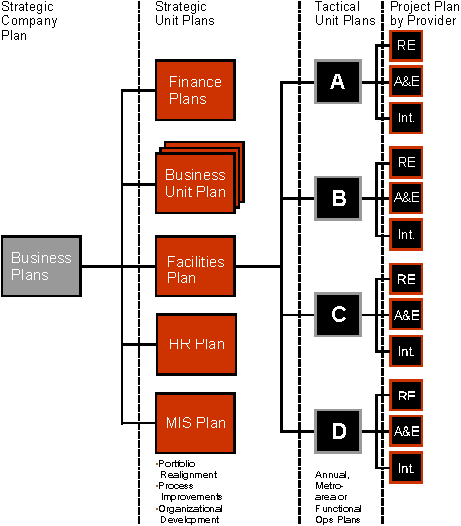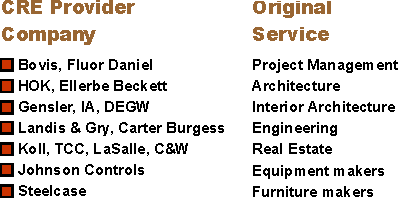Ally or Die: On the Corporate
Front, "Teaming" is the Trend of Today's Strategic Planning
by William T. Adams, FAIA, Program Management
In contrast to the past, today's corporate real estate units are shifting from a support role to take on more business-based responsibilities. This shift suggests a changing role for professionals in corporate real estate (CRE), a new role that requires greater fiscal planning and strategic responsibilities.
With these expanding responsibilities, corporate real estate executives need to be increasingly aware of life costs, accounting methods, changes within their company and its industry, as well as ongoing changes within the real state and facilities service sector in general. Corporate real estate executives are under increasing pressure to find innovative ways to streamline the company’s property portfolio, both to reduce costs and improve business operations, as real estate now often exceeds 25 percent of the company’s total assets.
In this business landscape, "facility providers" such as architects, contractors, and consultants - looking to best make use of this expanding market - should become familiar with changing corporate real estate and facility dynamics.

A Future of Teams and Plans
It’s been suggested that CRE planning will become a team activity, even though facility planning takes place at several levels with strategic, tactical, and project plans. Recent consulting assignments for large companies suggest smaller teams are being used in strategic planning and these assignments are closed to many traditional outside providers. In these strategic planning efforts, internal teams typically address:
| portfolio realignments, | |
| process and policy improvements, and | |
| organization development |
For example, there are numerous case studies of high-profile consulting firms (such as Arthur Andersen and E&Y/Leventhal) carrying their business and finance plans across to the real estate function and participating in these confidential assignments. Also, smaller nonaligned facilities specialists have successfully assisted large corporations in these efforts. Some examples include Facility Decision’s studies for Shell; Apgar & Associate’s efforts with Disney Europe, and Program Management’s work for TRW’s Space & Electronics and Information Systems units.
In contrast, facility planning work to implement agreed strategies usually involves more outside players. These tactical and project planning efforts are also often a larger body of work which, by its nature, must be more open and consensual to be effective.
Smaller, Better, Faster
CRE execs are being directed to reduce costs. Although organizations are being reduced, overall management responsibility is often the same or greater. They must deal with fewer vendors to reduce costs and become more customer responsive. To do this, remaining managers must focus on "core competencies." These are generally central functions and not project oriented. Specifically, they are:
| real estate and facilities information systems, strategic planning, | |
| operations coordination, | |
| quality control, | |
| purchasing, and | |
| communications. |
Thus, many responsibilities are being transferred to vendors, including real estate transactions and administration (asset management), project management, planning and design (interiors, architecture, and engineering), and facility operations. In turn, vendors must reposition themselves to accept and better respond to these new opportunities.
From Projects to Portfolios
As vendors assume more responsibility for annual plans and project-oriented work, these special-purpose teams often replace those responsibilities of management levels that have been eliminated. All traditional "providers" of CRE services are being contacted first by companies seeking an array of services necessary to pursue corporate strategic plans.
To better understand these future clients, all vendors should become better aware of business concerns leading to new real estate and facility strategies. These concerns include:
| capital and expense spending, | |
| allocation of assets (lease/owned property mix), | |
| more productive use of assets (e.g. building efficiencies, new space standards, energy reduction programs), | |
| accommodations for the changing mix of corporate employees, (i.e. full-time versus part-time, temporary and telecommuting employees), and | |
| improved methods of monitoring performance. |
As CRE departments become smaller, more responsibilities and operational programs will first shift to fewer, more geographically-dispersed single or allied providers. Next, with further corporate staff reductions, it will be necessary for CRE executives to turn to large, single integrated providers familiar with separate CRE activities. Four CRE service areas typically being outsourced are:
| facility management or operations, | |
| planning and design (interiors, architecture, and engineering), | |
| real estate (asset management), | |
| project management. |
Ally or Die
To compete with large integrated CRE service firms of the future, today’s "project alliance" providers must focus on ongoing relationships and become "self-managed teams" of global specialists with lower overhead costs. This will require some effort, as the cumulative cost of duplicated management overhead for a consortium can prevent competitive bidding.
Sun Microsystems’ recent move from one large integrated CRE provider to this self-managed team format may prove to be an ideal industry test case for this approach. It also mirrors Sun’s business philosophy in their approach to many manufacturing operations.
Team Spirit
As a first step in "teaming" for a single CRE service such as real estate transactions and administration, many firms are establishing national and international networks to compete with large, dispersed firms. The most notable example of teaming for CRE services to date has been in the growth of real estate networks.
ONCOR, New America, and CRESA networks were formed to compete with Cushman Wakefield, Grubb & Ellis, and CB Commercial’s nationwide corporate service operations. Although the next evolutionary step to develop more fully integrated CRE service firms may be difficult, many efforts are now underway.
In response to this first teaming challenge of "seamless geographic services," many candidate CRE providers are physically expanding or teaming to effectively become larger and more global. These include firms which originated and specialized in one CRE service sector - but then added others to offer expanded CRE services. Examples of these include:

Many of these large firms are ideal candidates for "alliance team leaders." It’s these new "alliance team leaders" that may become interior designers’ primary corporate clients in the future. Examples of this shift in client structure can be seen with many planning and design firms now working for real estate companies operating as "project consolidators." Examples of these are the Staubach Company for MCI; Keewaydin for Target Stores, and Lincoln Properties for Nations Bank.
Clients and Critical Mass
Planning responsibilities and partnering concepts are both functions of a client’s size, location, and diversity. In a small, growing company, a design firm’s client may be a CFO who also serves as the Director of Real Estate and VP of Corporate Services. In that case, the company may contract for only interior design services, but the provider must be positioned to offer advice on strategic planning.
A small planning a and design practitioner should learn more about business planning tools and measures. This includes organization development concepts, operations analysis methods, financial models, and CRE performance goals for various service activities and asset portfolios.
In a case of a long-standing client relationship or a somewhat larger corporate assignment, a mid-size planning and design firm may sometimes be asked to actively assist in a strategic facility plan. This "planning and design" provider should be sufficiently prepared to draw upon business and financial specialists or team with a specialty consulting firm.
Also, as larger corporate portfolio planning programs are often more confidential, decisions about those strategic facility plans are usually isolated from providers to assure management recommendations are unbiased. This allows CRE vendors with an interest in the program to be kept t arm’s length until plans are finalized. However, providers may sometimes find it useful to team with specialist strategic planning consultant’s as they begin to implement those programs.
Several name-brand consulting organizations that specialize in CRE services are prime candidates to assist, as they have a reputation for fiduciary responsibility and objectivity. However, "strategic planning consultants" are often small specialist firms with a collection of uniquely talented and experience professionals.
Team Guidelines
Since many facility design and delivery-oriented firms lack experience with business aspects of corporate facility planning, they sometimes have an interest in partnering with consultants to develop strategic plans for smaller clients or team with similarly skilled providers to implement global or nationwide programs.
When considering "teaming," several guidelines are suggested:
| Identify an appropriate long-term alliance early. Response time may be limited and long term relationships are more critical. | |
| Select as few partners as possible. Focus on those with more comprehensive skills. | |
| Position your firm to team with others familiar with a client’s industry (i.e. semiconductor manufacturing, software development, biotechnology research). | |
| Select partners uniquely skilled in their area of expertise. | |
| Select an "organization" which will not overwhelm either your firm or the client - unless you plan to be acquired. | |
| Team with a forward-looking and adaptable partner. The new corporate CRE environment is often volatile and many of the changes described are accelerating. | |
| Select partners which help differentiate you "team" from the competition. |
Return to Articles
Copyright All Contents
© 1995-2002 Corporate Facility Planning, All Rights Reserved